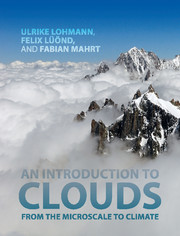Book contents
- Frontmatter
- Dedication
- Contents
- Preface
- List of symbols and acronyms
- 1 Clouds
- 2 Thermodynamics
- 3 Atmospheric dynamics
- 4 Mixing and convection
- 5 Atmospheric aerosol particles
- 6 Cloud droplet formation and Köhler theory
- 7 Microphysical processes in warm clouds
- 8 Microphysical processes in cold clouds
- 9 Precipitation
- 10 Storms and cloud dynamics
- 11 Global energy budget
- 12 Impact of aerosol particles and clouds on climate
- References
- Index
7 - Microphysical processes in warm clouds
Published online by Cambridge University Press: 05 June 2016
- Frontmatter
- Dedication
- Contents
- Preface
- List of symbols and acronyms
- 1 Clouds
- 2 Thermodynamics
- 3 Atmospheric dynamics
- 4 Mixing and convection
- 5 Atmospheric aerosol particles
- 6 Cloud droplet formation and Köhler theory
- 7 Microphysical processes in warm clouds
- 8 Microphysical processes in cold clouds
- 9 Precipitation
- 10 Storms and cloud dynamics
- 11 Global energy budget
- 12 Impact of aerosol particles and clouds on climate
- References
- Index
Summary
In Chapter 6 we discussed how cloud droplets are activated. Both before and after a droplet reaches its critical size, it grows by the uptake of water molecules from the vapor phase. Water vapor molecules are transported by diffusion towards the droplet where condensation takes place at the droplet surface. This is called diffusional or condensational growth (Section 7.1). Additional processes involving collisions with other droplets are required for the droplets to reach precipitation size, since diffusion of water vapor alone can be too slow to produce precipitation-sized drops on the time scales observed in the atmosphere. This growth is referred to as growth by collision–coalescence. It is induced by the difference in terminal velocity of the larger and smaller drops. Diffusional growth (and evaporation) and growth by collision–coalescence (Section 7.2), along with evaporation and the breakup of raindrops, which limits raindrops to a maximum equivalent radius of around 5 mm (Section 7.3), are discussed in this chapter.
Figure 7.1 shows typical sizes for a CCN, a cloud droplet, a drizzle drop and a raindrop, along with their typical concentrations in the marine atmosphere: typical marine CCN concentrations range between 102 and 103 cm-3 while that for cloud droplets is only around 102 cm-3 (Kubar et al., 2009). This shows that for typical supersaturations (0.1%–1.6%) in the atmosphere not all CCN are activated to become cloud droplets (Chapter 6), i.e. the number of cloud droplets is less than the number of CCN.
After activation a cloud droplet must grow by two orders of magnitude in radius in order to reach the size of a raindrop, with typical radius 1 mm. Put differently, it requires a million cloud droplets to form one raindrop. Raindrops are large enough to overcome the updraft velocities within a cloud and leave the cloud as precipitation. Their large sizes explain their typical concentration, of only 10-4 cm-3 (100 m-3), which is six orders of magnitude smaller than that of cloud droplets. Drizzle drops have sizes in between cloud droplets and raindrops, with radii between 25 µm and 0.25 mm (Table 1.2). Their typical concentration in marine clouds is 0.1 cm-3, which is three orders of magnitude smaller than that of cloud droplets (Wood et al., 2009) and three orders of magnitude larger than that of raindrops.
- Type
- Chapter
- Information
- An Introduction to CloudsFrom the Microscale to Climate, pp. 186 - 217Publisher: Cambridge University PressPrint publication year: 2016
- 2
- Cited by

